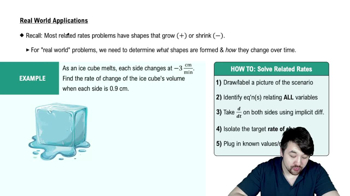Table of contents
- 0. Functions7h 52m
- Introduction to Functions16m
- Piecewise Functions10m
- Properties of Functions9m
- Common Functions1h 8m
- Transformations5m
- Combining Functions27m
- Exponent rules32m
- Exponential Functions28m
- Logarithmic Functions24m
- Properties of Logarithms34m
- Exponential & Logarithmic Equations35m
- Introduction to Trigonometric Functions38m
- Graphs of Trigonometric Functions44m
- Trigonometric Identities47m
- Inverse Trigonometric Functions48m
- 1. Limits and Continuity2h 2m
- 2. Intro to Derivatives1h 33m
- 3. Techniques of Differentiation3h 18m
- 4. Applications of Derivatives2h 38m
- 5. Graphical Applications of Derivatives6h 2m
- 6. Derivatives of Inverse, Exponential, & Logarithmic Functions2h 37m
- 7. Antiderivatives & Indefinite Integrals1h 26m
- 8. Definite Integrals4h 44m
- 9. Graphical Applications of Integrals2h 27m
- 10. Physics Applications of Integrals 2h 22m
4. Applications of Derivatives
Related Rates
Problem 24
Textbook Question
Once Kate’s kite reaches a height of 50 ft (above her hands), it rises no higher but drifts due east in a wind blowing 5 ft/s. How fast is the string running through Kate’s hands at the moment when she has released 120 ft of string?
 Verified step by step guidance
Verified step by step guidance1
Identify the right triangle formed by the height of the kite, the horizontal distance from Kate to the kite, and the length of the string. The height is constant at 50 ft, the horizontal distance is changing, and the string length is 120 ft at the moment of interest.
Use the Pythagorean theorem to relate the sides of the triangle: \( s^2 = x^2 + 50^2 \), where \( s \) is the length of the string and \( x \) is the horizontal distance.
Differentiate both sides of the equation with respect to time \( t \) to find the relationship between the rates of change: \( 2s \frac{ds}{dt} = 2x \frac{dx}{dt} \).
Substitute the known values into the differentiated equation. At the moment of interest, \( s = 120 \) ft, \( \frac{dx}{dt} = 5 \) ft/s, and solve for \( \frac{ds}{dt} \), the rate at which the string is running through Kate's hands.
Calculate \( x \) using the Pythagorean theorem: \( x = \sqrt{s^2 - 50^2} \). Substitute \( x \) and the other known values into the differentiated equation to find \( \frac{ds}{dt} \).
 Verified video answer for a similar problem:
Verified video answer for a similar problem:This video solution was recommended by our tutors as helpful for the problem above
Video duration:
6mPlay a video:
Was this helpful?
Key Concepts
Here are the essential concepts you must grasp in order to answer the question correctly.
Related Rates
Related rates involve finding the rate at which one quantity changes in relation to another. In this problem, we need to determine how fast the string is being released as the kite drifts horizontally while maintaining a constant height. This requires applying the concept of derivatives to relate the rates of change of the kite's height, the horizontal distance, and the length of the string.
Recommended video:

Intro To Related Rates
Pythagorean Theorem
The Pythagorean theorem is a fundamental principle in geometry that relates the lengths of the sides of a right triangle. In this scenario, the height of the kite, the horizontal distance it drifts, and the length of the string form a right triangle. Understanding this relationship is crucial for setting up the equation that connects the variables involved in the problem.
Recommended video:

Fundamental Theorem of Calculus Part 1
Chain Rule
The chain rule is a formula for computing the derivative of a composite function. In the context of this problem, we will use the chain rule to differentiate the equation derived from the Pythagorean theorem with respect to time. This allows us to relate the rates of change of the string length and the horizontal distance, enabling us to find the speed at which the string is being released.
Recommended video:

Intro to the Chain Rule
Related Videos
Related Practice





